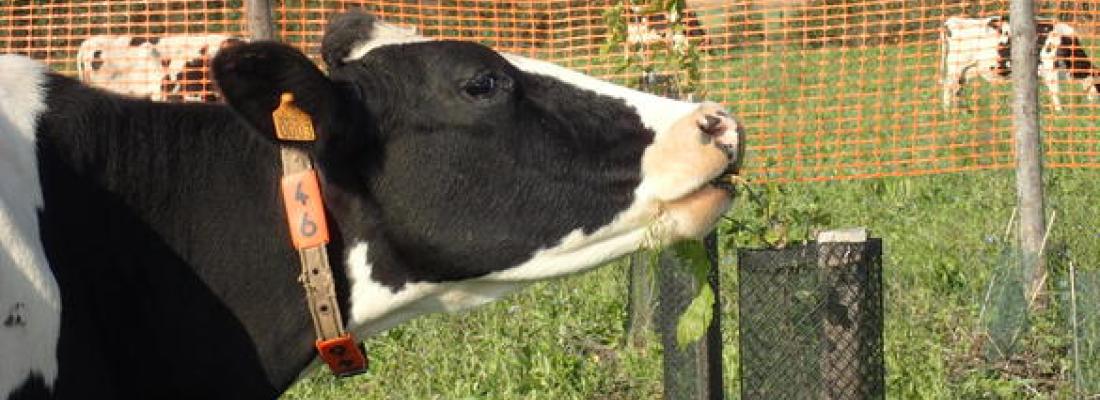Agroecology Reading time 4 min
Trees to feed the cows
Published on 26 March 2019

It has long been advantageous to associate livestock with crops in lowland areas: a portion of the crops can be used to feed the animals who, in turn, help fertilise the soil. To encourage this sort of mixed crop-livestock farming, INRA Lusignan is testing a dairy cow feeding system which aims to reduce inputs (water, fossil fuel) and resist the effects of a fluctuating climate. This system is based on the use of different sorts of pasture… including trees, thanks to an innovative form of agroforestry: trees that can be pollarded and grazed by the animals.
Of cows and pollards
At INRA’s Lusignan Experimental Unit for Forage, Environment and Ruminants, a cattle feeding method that has never been tested before has been launched for the farm’s 72 cows. They will soon be able to graze the leaves of cut or pollarded trees. The pollarding of trees around fields is thousands of years old. Peasant farmers would crop the young branches back to the trunk every year and scatter them on the ground for the animals to graze on or burn them as firewood. The thicker branches could also be used as timber. The Lusignan experiment will be the first time standing trees have been used as a food source for cattle during the summer months when grass is scarce.
“We planted the trees in 2014” says experiment leader Sandra Novak “and in February 2019 we pollarded them for the first time, with the help of France’s tree pruning and pollard specialist Dominique Mansion. His supervision was very reassuring because it’s a drastic cut, you leave practically nothing but the trunk! We won’t let the cows graze these trees until 2021”.
An autonomous, agroecological farm
Though experimental, the farm makes its living from the sale of its milk and cereals. The underlying principle is to produce as much forage as possible on the farm itself in order to feed the cows without buying in extra fodder. To achieve that goal, INRA has developed a 20-year system experiment1that makes use of the advantages of agroecology, in particular forage diversification and agroforestry. Three rotations supply forage in all seasons. The first grazing area, situated near the cowshed, is made up of meadows with additional plots of millet-clover and beetroot which provide extra forage in summer and winter respectively. A little further away from the shed, the second grazing area is also composed of meadows but with plots of sorghum and meslin that can be grazed on or harvested depending on the climatic conditions in a given year and the demand for preserved fodder. The third area, which is not used for grazing, is in meadow-crop rotation (wheat, maize, sorghum, protein crops) and produces forage, straw and grain that is sold by the cooperative.
Each area is associated with a different type of tree: pollards and vines in the grazing areas to provide well-aerated grassland in summer; high pollarded trees2useful for carbon capture, soil fertilisation, auxiliary fauna and shade. "In the intermediary zone, where the grazing is less frequent, we have carried out even more innovative tests" says Sandra "with a mix of ‘multi-functional’ trees: high pollard, coppice and pollard, that also serve as support for creepers: vines, hops or kiwis".
A system that works and unanswered questions
Set up in 2013, the system is economical in its use of pesticides, nitrogen fertilisers and water (grass grazed by animals is 80% water). It also provides environments that favour biodiversity. The use of trees as forage has been facilitated by previous research but many questions remain. "We still don’t know if the cow-pollard couple will work out" says Sandra. "Will the trees survive the grazing of their leaves? What are cows’ feeding preferences and how much of this forage can they ingest? We don’t have answers to these questions but, as researchers, we owe it to ourselves to take the risk to explore innovative approaches".
1 System experiment called Oasys, Lusignan Experimental Unit for Forage, Environment and Ruminants (Ferlus), INRA Nouvelle Aquitaine - Poitiers.
2 High pollards: not pruned but cut and sold for timber.
In conventional systems, cows produce one calf a year and provide milk for ten months after calving. Following their first calving, they are inseminated after the third month of lactation so as to produce a calf nine months later. They gestate and provide milk at the same time and, generally, their career ends after the second lactation due to reproduction difficulties. At Lusignan, the cows calve every 18 months, are inseminated in the 9th month of lactation and lactate for 16 months. The objective is to get at least three calvings. To meet that aim, Friesian cows were crossed with Jersey then Scandinavian Red bulls in order to combine quality of reproduction with milk production, resistance to heat and small size.
